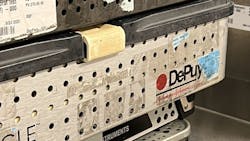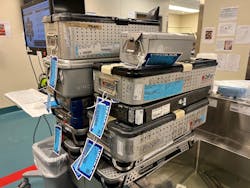Sticky Residue: A Possible Contaminant That Shouldn’t Be Overlooked
Cleaning, inspecting, packaging, sterilizing and storing instruments and medical devices is a daily routine for sterile processing (SP) staff. For these critical processes to function most effectively, SP and perioperative and procedural staff must work together to ensure instruments used during surgical procedures are clean, sterile, well-functioning, and safe for use.
If bioburden (i.e., blood, tissue, bone) is found on a surgical instrument, the device should be considered unsterile and should not be used because of the risk of infection to subsequent patients. Even so, after surveying dozens of hospital staff from the SPD and OR, it is apparent that not enough attention and understanding are given to surgical instruments with pitting, cracks, etching, corrosion and oxidation, damaged insulation and connectors, and more. Often, staff will continue using the instruments as if nothing is wrong.
Adhere to safe practices
Similar challenges arise from sticky residue that remains on instruments and containers. This can stem from poorly applied or degraded instrument tape and glue residue from instrument tray identification. I have personally consulted with dozens of clients across the country and it is rare to find a program that does not have one or more of these problems. SP professionals spend countless hours putting instruments and devices through a rigorous cleaning process, only to frequently leave sticky residue on instrument pans, baskets, and devices themselves, going on to process them as if no problem exists. Make no mistake, however: Adhesives and other sticky residues can interfere with the sterilization process, making the devices a potential patient safety and infection risk.
All residues and adhesives must be removed completely prior to initiating the cleaning process. If an instrument, instrument set, or device arrives in the assembly area with remnants of tape, stickers, or other residue sources, those residues must be removed completely—with an approved product and in strict accordance with the instructions for use (IFU)—and the item should then be returned to the decontamination area for processing. Only when the items are cleaned and inspected fully and appropriately should they be deemed ready for sterilization or high-level disinfection.
Conclusion
SP professionals are expected to process and assemble high volumes of complex surgical instruments and sets with efficiency and accuracy. Even so, too many healthcare organizations across the country fail to stress the importance of removing sticky residues from devices and containers.
The result of present residues can be infections and other dangers to patients who are exposed to such devices. All processing professionals must be aware that residues remaining on medical devices, baskets, and containers can impede proper cleaning and render sterilization or HLD ineffective. SP technicians must also be provided with the tools and knowledge to remove sticky residue safely and effectively. In all aspects of healthcare, science matters. When instruments are being processed, they must be done safely, consistently, and thoroughly, and according to the latest standards, IFU, and policies and procedures.
About the Author

David Taylor
Principal, Resolute Advisory Group LLC
David L. Taylor, MSN, RN, CNOR is an independent hospital and ambulatory surgery center consultant and the principal of Resolute Advisory Group LLC, in San Antonio, Texas.


